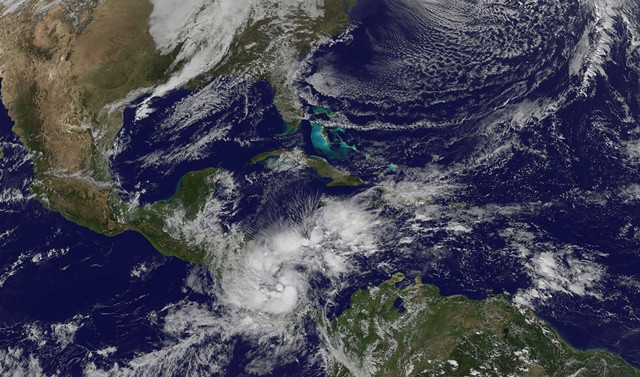Costa Rica, Nicaragua brace for deadly Hurricane Otto
Both countries had issued red alerts for the areas to be worst-hit, evacuated thousands of people

Tropical Storm Otto was forecast to strengthen into a hurricane with winds over 119 kilometers (74 miles) per hour when it makes landfall on Thursday, the US National Hurricane Center said. PHOTO: AFP
It will be the first time Costa Rica takes a direct hit from a hurricane since records began in 1851.
Hurricane Otto, upgraded from a tropical storm by the US National Hurricane Center, was packing sustained winds of 140 kilometres (85 miles) per hour that were forecast to strengthen further before landfall. The slow-moving system was expected to churn slowly through northern Costa Rica and southern Nicaragua over two days, dumping heavy rains that the US center warned would likely cause "life threatening flash floods and mudslides."
One dead, three injured in Haiti aid distribution chaos
Both countries had issued red alerts for the areas to be worst-hit, evacuated thousands of people and ordered the closure of schools, some of which were designated shelters. Costa Rican President Luis Guillermo Solis' declaration of a national emergency meant government offices in his country would be closed Thursday and Friday, except the ones dealing with the storm.
"Let me be clear: the hurricane is potentially highly destructive. We hope no one gets hurt, but that is why we must be prepared, and follow authorities' orders," Solis warned.
In Bluefields, a Nicaraguan city of 45,000 inhabitants directly in the storm's path, there was panicked buying of battery-powered lamps, bottled water, canned food and plastic bags.
"I'm expecting it won't hit Bluefields directly... but it's worrying that it's stationary because it's growing bigger and taking up a lot of water and has become unpredictable -- it could go in any direction," a shopkeeper, Elmer Jackson, told AFP by telephone.
Otto has already proved deadly in Panama, where on Tuesday its outer band of rains and wind caused a mudslide that killed two people, brought down a tree that crushed a nine-year-old boy in a car in the capital, and drowned an 18-year-old swept away by the Utive River.
Princes Barberena, a resident in Greytown, an outpost on Nicaragua's far southern Caribbean coast, said some locals were crossing the nearby border into Costa Rica looking for safer shelter.
But the situation there was not projected to be much better. Costa Rican officials have ordered the evacuation of more than 4,000 people along the sparsely inhabited northern half of its Caribbean coast. But some were defiantly staying.
"Some people don't want to leave their homes, leave all their possessions, their animals," police officer Christian Rodriguez told the Costa Rican newspaper La Nacion in the village of Batan, close to the Caribbean port city of Limon.
One woman who did evacuate her home near the village of Barra del Colorado, Teresa Romero, 52, told AFP that around 10 male locals had refused to leave. She was taking shelter in a church near the inland capital of San Jose.
The high winds and heavy rains could devastate crops -- a big blow especially in Nicaragua, one of the poorest countries in Latin America. Otto "could seriously jeopardize food security for small farmers who rely on maize (corn), beans, cocoa, honey, coffee and livestock for their livelihoods" in Nicaragua, Jennifer Zapata, a regional director for Heifer International, a US-based poverty-fighting charity, said in a statement.
Hurricane-hit southern Haiti cut off after bridge collapse
"The storm is coming at a terrible time for the vital coffee crop, which is usually harvested between now and December," she said.
Otto was a rare, late-appearing hurricane in the Atlantic storm season, which runs from June to the end of November. It was also on an unusually southern trajectory.
A previous, far-stronger hurricane, Matthew, devastated parts of southern Haiti early last month, killing 546 people and leaving nearly 175,000 homeless.
The US National Hurricane Center said up to 50 centimeters (20 inches) of rain could fall on parts of northern Costa Rica and southern Nicaragua between Wednesday and Thursday. Dangerous surf and rip tides were also likely, it said.
In addition, "the combination of a dangerous storm surge and large and destructive waves could raise water levels by as much three to five feet above normal tide levels in areas of onshore flow within the hurricane warning area," it said.



















COMMENTS
Comments are moderated and generally will be posted if they are on-topic and not abusive.
For more information, please see our Comments FAQ